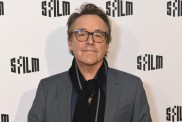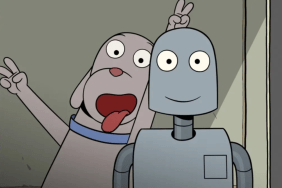A few years back, ComingSoon.net spent a day with the makers of DreamWorks Animation’s Madagascar in San Francisco and learned what kind of time and care was put into every one of their computer animated films in order to deliver such high-quality material. Few would realize that it’s not nearly as easy as it looks, which is why it takes hundreds of animators many years and tens of millions of dollars to bring their unique animated visions to life.
Although he wasn’t there that day, John Stevenson was one of the many artists who worked on bringing that talking animal movie to life, and now he’s at the helm of DreamWorks Animation’s latest concept, Kung Fu Panda, a comedy featuring the voice of Jack Black as Po the Panda, a lazy slacker who dreams of being a martial arts master, a wish he’s granted when he inadvertently becomes the chosen one to take on the evil snow leopard Tai Lung (voiced by Ian McShane) who has recently escaped.
A veteran of DreamWorks PDI who got his start in the entertainment industry via Jim Henson’s “The Muppet Show,” Stevenson worked for many years in the art department on many films at DreamWorks before helming a number of episodes of their animated primetime show “Father of the Pride.” For the last five years though, he’s been working on bringing Kung Fu Panda to the screen, a laborious process which he talked with ComingSoon.net about while on the road promoting the film, delving into the thought-process that went into keeping the film faithful to the kung fu and martial arts films that inspired it. A lot of what he had to say will certainly be of interest to anyone hoping to one day break into the animation or computer effects field.
ComingSoon.net: You’ve been at DreamWorks a long time, so what’s the path as far as going from being in the art department and getting a chance to direct?
John Stevenson: I came to DreamWorks as a Head of Story, and a Head of Story is the person who’s in charge of the Story Department on a feature film. It’s a mixture of skills, it’s part management and part story artist and part interfacing with the directors to understand their vision and then pass that onto a team of between 8 and 12 people on the story team. I’d already been the Head of Story twice before, so I was experienced Head of Story, and they needed (that) at PDI DreamWorks, so I came in at that position. That doesn’t stop you working as a story artist, which I’d done on a bunch of films, but I joined the company to be the Head of Story on a film that ultimately ended up not getting made at DreamWorks, called “Tusker.”
CS: Is Head of Story comparable to being an A.D. (assistant director) on a live action movie?
Stevenson: Yeah, it’s a weird position. I don’t think it really has a live action equivalent, because the story process on an animated film is really the key filmmaking tool. It’s the department, which is sort of first-in and last-out, because you’re always tinkering with the story all the way up to the end, and it’s where we make all our mistakes and work things out before we commit to the process of animation. The best live action analogy isn’t actually a filmmaking one, it’s more like a theatrical one. Our story process is like doing rehearsal in a theater or putting a show up in Seattle that you’re finally going to take up to Broadway. It’s where you take things on the road and you try them and refine them until you’re ready to do the final product. That’s all because animation is so expensive and so labor-intensive that you don’t want to commit to your resources until you’re absolutely certain that you’ve made the best decision. The best and easiest and actually cheapest, which is the reason the storyboard process was initiated by Disney in the ’30s, was to manage costs by careful planning and working out all your ideas just with simple story sketches, which we film and put temporary music and just temporary voices–usually everyone on the crew will just record their voices. Even with those very crude simple tools, you can see whether a scene has a chance at working from that. If you see that it’s playing, then you can bring in the actors to record the voices properly. Once you’ve done a lot more work, you can then commit all the resources of animation to actually doing it. It’s a very common path to directing to go from being a story artist to being a Head of Story to being a director. Being a Head of Story means that you have a sense of the shape of the whole movie, and that’s a very critical thing on any film, but particularly animation. It can take four years and keeping a big picture framework is vital, because you can get so lost in the details you have to have a sense of how all the pieces are going to fit together and make a cohesive whole.

CS: Having been the director on this one for over four years, were you still doing other things at the same time or just focused on this?
Stevenson: No, once you’re directing on an animated film, that’s your life for four long years. There is no room in your life for anything else. You’re doing it long days, weekends, late nights. There’s not even room to have a life really. You’re just doing the movie.
CS: I wanted to quickly ask about your background coming from Henson Studios and how you made the transition to doing animation at DreamWorks and what you’re doing now.
Stevenson: It’s pretty easy. First of all, I loved animation as a kid, and I taught myself to draw by looking at animation on TV, and secondly, the same imaginative forces that power the creation of something like the Muppets are exactly the same as power something like an animated film, whether it’s short or long. It’s that kind of imaginative thinking in terms of non-human main characters or fantastic worlds, and at the beginning, you’re just dreaming and thinking and working with images, and you haven’t concretized the technique, whether you’re going to do it as drawings or computer graphics or puppets or whatever. The creative process for coming up with that stuff is the same. The choice is made later whether it’ll be animation or puppetry or effects or whatever.
CS: Having attended the “Madagascar” junket, I understand the system of storyboarding used by DreamWorks Animation, but I thought they mentioned having some of the actors’ cast and recorded before starting, so did you have some of them in place during the storyboard phase of this movie?
Stevenson: Well, no, you start with nothing. What happens is you start with ideas, then you start doing those ideas as storyboards and then you start recording yourself, just to get a sense of it, and then you bring in your actors and you start recording them. In the beginning, all their voices are cut in against the story reels and then what happens is that when you assemble your film for the first time, it’s all story reel and probably maybe 70% is it with scratch voices, and maybe 25% if you’re lucky is with actual talent. Over the course of the four years, the 100% storyboards starts to become 75% storyboard, 50% animation then 50% storyboard, 50% animation, so eventually, it’s all animation and the scratch voices give way from being 70 80% scratch at the beginning
the more you record, the more you cut that into the reel, so eventually, you start with just scribbles and you end up with a full film with all the right things.
CS: But generally, you still do all the voice recording first before starting the animation?
Stevenson: Always, always.
CS: You’ve been in animation long enough to know that a lot of ideas end up being recycled whether it’s the penguins of “Happy Feet” and “Surf’s Up” or “Antz” and “A Bug’s Life.” “Kung Fu Panda” is a completely new and original idea and it’s surprising that no one has thought of doing some kind of kung fu movie with talking animals before. Who came up with that?
Stevenson: Yeah, it was a big high concept idea that had been at the studio that everybody had liked the idea and the sound of, but it hadn’t found its voice when I started working on it. When Mark Osborne and our producer Melissa Culp came onto the film, it had been an idea in search of an execution. I think the way it had started was more leaning towards parody and sort of a spoof and those kinds of choices, which we didn’t think were very interesting. I don’t really think parody stuff plays much longer than about a ten-minute “Saturday Night Live” sketch. It doesn’t emotionally involve you, it doesn’t hook you in, and the other thing was that we love martial arts movies. I wasn’t interested in making fun of them, because I really think martial arts movies can be great films, they can be as good as any genre movie when they’re done properly. They give you the ability to deal with these big sweeping emotions and action and this breadth of content if you embrace it and take it seriously. Our choice was to not do the parody or the simplistic comedy. We said, “Let’s take ‘Kung Fu Panda’ which is an idea everybody gets comedically, but then let’s try and surprise everybody by giving them more movie than they might expect from the title. Let’s try to make it a real martial arts movie albeit one with a comic character and let’s take our action seriously. Let’s not give anything up to the big summer movies. Let’s really make sure that our kung fu is as cool as any kung fu ever done, so that we can take our place in that canon and make sure it’s a beautiful movie, because great martial arts movies are really beautiful-looking movies and then let’s seen if we can imbue it with real heart and emotion. We kind of hoped that maybe when people see the movie, they’ll be surprised that they get a bit more movie than they may be expecting from the title.

CS: I want to talk about your collaboration with Mark Osborne. You’ve been at DreamWorks a long time, over ten years, while he was kind of a new guy, similar to the pairing of Eric Darnell and Tom McGrath on “Madagascar.” Can you talk about how the two of you were teamed and what each of you brought to the table while making the movie?
Stevenson: It’s kind of an arranged marriage. They look and see who might make a good mix. These things take so long that it’s good to work with someone who can help carry the load for four years. Obviously, you try and compliment each other’s strengths and mitigate each other’s weaknesses and maybe bring slightly different skill sets to the table. Mark, his background is in stop motion animation. He’s an Academy award nominee for his short film “More.” He’s very hands on as a stop motion animator. My background is all in art and design and that kind of thing. Although we were both intimately involved in all aspects of the film–the story, in editorial and everything–it kind of broke down to Mark working with the animators on a daily basis, and I sort of set the art style for the film, and I would work with our lighting department, which is where we put our final color. Basically, we would split up in the afternoons and Mark would go to animation and I would go to lighting. In that way, we divided and conquered, we like to think.
CS: I was wondering who put together these teams, if there was some sort of Wizard of Oz-like overseer who says, “I will put this person with this person and they’ll work together for four years.” I thought there must be more to bringing two directors like this.
Stevenson: As I’ve said, it’s not done thoughtlessly. It’s obviously done with trying to make the best recipe for the success, and get the best people to bring whatever’s needed to make the film good. Obviously, we wanted the movie to be beautiful looking and we also wanted to raise the bar across the board on everything, but particularly with the animation, so I think that was the reason for the partnership was maybe Mark could get the animation to excel and maybe I can help make the movie look like something special.
CS: It seems like computer animation, more and more, does seem to require two directors to get them done in a timely manner.
Stevenson: But not necessarily. Obviously Brad Bird did The Incredibles and Ratatouille and Miyazaki in Japan, he’s a singular director and vision, and Andrew Stanton directed Finding Nemo and WALLE, but also worked with John Lasseter on A Bug’s Life. (Note: Stanton had a co-director for “Nemo” as well.) Partnerships work and single directors work. I don’t think there’s an either or, it’s whatever gets the job done the right way.
CS: While watching this, it was obvious to me that someone involved in this was really a fan of kung fu movies, especially in scenes like the dumpling fight which is right out of Shaw Brothers or other classic kung fu films. Were you the main person who brought that or were there others involved who brought that to the table?
Stevenson: Many skilled people worked on all aspects of the movie. Getting the kung fu right, getting the martial arts right, was the biggest technical and artistic challenge on the film and one we knew we had to live up to when we had “kung fu” in our title. There were many skilled people who worked on that. Our Head of Story was Jen Yuh-Nelson, and she and a brilliant story artist called Simon Wells, who’s also a director in his own right–he directed animated films, he directed the live action “Time Machine”–they kind of gave our action shoot scenes the basic shape. They did this with some input from the rest of the story team and also the production designers, and then we had a story artist and one of our lead animators is a French animator who’d done martial arts for 20 years, so he would then work within those scenes and actually insure that the specific martial arts moves were accurate and correct.
CS: Most live action movies would have someone like Yuen Woo-ping or one of his brothers choreographing the action.
Stevenson: We thought about that, either going to Jackie Chan or Yuen Woo-ping at the beginning, and then we just realized that those guys, they work in a very specific way. They work with the physicality of the world, specific locations, specific props and their action choreography is based on those things, and they work with real stuff and real constraints and then try and exceed them. We’re working in a virtual world, and also, our characters are animals, and we wanted to really use animal’s anatomy–we have insects and snakes and birds, things that don’t really correlate to human anatomy–and we didn’t want our kung fu to look like it was done with guys wearing animal suits. We wanted it to be unique and the unique aspect to our film was to use the actual anatomy of the animals, and the animals we’re using, the Furious Five, are based on the original five animal fighting styles in kung fu–tiger, crane, monkey, mantis and snake-style–so our big conceit was, “Well, how does it look to see the original animals that inspired the kung fu moves that shaolin monks adopted. How does an animal do that as opposed to how a human being imitates that animal?”

CS: A lot of kung fu film fans might not even know that stuff, so it’s impressive that you went that far into the thought process for choosing the various animals.
Stevenson: It was one of the high concepts that we adopted early on and then we really wanted to adhere to it. There’s also a leopard-style, and Tai Lung is a leopard. Leopard style, it’s a slightly sneaky style, underhanded, because it analyzes your opponent’s style and looks for the weaknesses then turns that style against you, so we felt that was a good basis for our villain, and that’s why Tai Lung is a snow leopard.
CS: DreamWorks is very well known for their voice casts, getting the biggest stars. When we think about classic Disney characters like Snow White or Pinocchio, no one ever knew who provided their voices and people still love them, so I was curious what you thought of having stars creating these characters rather than some unknown voice actor.
Stevenson: The way we worked on “Panda” was first of all, we had worked out our characters in terms of what the story needs, so we knew who the personalities were and what we wanted from those characters. We also had them already designed, so we knew not only who they were but how they looked, but then we sat down and do some blue sky dreaming, like “Who in our wildest dreams would we like to embody this character?” When you start throwing names around like Dustin Hoffman and Angelina Jolie, you’re not necessarily assuming you’re going to get those people, but it’s useful to go, “that caliber of performance would define this character.” Then, how we get lucky is that Jeffrey Katzenberg can ring up those people and get you that answer. The answer we got across the board that made us thrilled was people wanted to be in the movie when they saw what we wanted to do with the characters, they agreed. We made a wish list, asked, and everybody we put on that wish list said “Yes” but they were chosen by us, because we couldn’t imagine better for that role, not because they were a big star.
CS: Were you able to show the actors some animation of their characters or just pictures beforehand?
Stevenson: Yeah. Sometimes we didn’t have that at the beginning, and actually Dustin (Hoffman) had a little bit of a hard time his first session. We’d robbed him of so many of his tools he’s normally comfortable with in acting, like he had no other actors, no sets, no costumes or make-up, so the first time he was there alone in a soundbooth doing a voice, looking at a drawing of his character, he really had a hard time imagining how this could work. The next time we got him in, we’d taken his voice and animated his character to it, and we could show him and he understood how his voice could sit in that character. In fact, he made some suggestions about widening the mouth a little and moving the teeth and doing some things, because he’s very smart about analyzing how his voice would work within the character that actually made him feel secure that it was going to work, and gave him an understanding that the level of animation was going to support his level of voice-acting. I think he worked as hard on Shifu as he’s worked on any performance. He really dug in, and it’s a very emotionally-complex character, and we asked him to do scenes over and over again to try and get them right, and really kept going until we’d hit the right emotional pitch. Shifu is not a particularly funny character, so a lot of his scenes were quite dramatic. It was a rare and wonderful experience to get to work with him.
CS: I’ve spoken to many actors who enjoy doing animation because they don’t have to do hair or make-up and can just walk in and do it, but as you say, it’s a real test for an actor to have to do that without having anything to see or watch.
Stevenson: Yes, which is one of the ways actor work, but you are working purely imaginatively. You have to be in a booth and then as directors, we try to give you, the actor, the context, but there’s never a finished script. The actors never have a finished script so they come in, and we do a scene at the end of the movie, and then they come in another time and doing a scene in the middle of the movie or the beginning or redoing a scene. It’s very hard for them to have a sense of how this is going to work together, and they really have to trust us, but it is going to work together and we obviously show them as much material that we finish as possible, so they’re always feeling included, but our process is long and complex, so often we don’t have much show for a long time. It asks a lot of actors. They really have to trust us to treat their work with respect and handle it properly.

CS: Jack Black has done a lot of animation voice work before, such as on “Shark Tale” and “Ice Age,” so he’s comfortable with doing it.
Stevenson: Yeah, he was really comfortable doing it. In fact, Jack had a very predictable acting rhythm, which we’d do what we call our “plain vanilla” takes which we’d just read through the scene a couple of times. Takes 1 and 2, takes 3 and 4 he’s warming up, takes 5 and 6, he’s hitting the golden place, and Jack is such a good self-monitor that he always knew, and he would tell you, “That’s the golden take” or he’d say “I need another one” but you’d always know with Jack how that would work. With Dustin, it was much more
I guess slightly messy and more organic. He described it as oil painting, as he was sort of searching and questioning for the right take. But we always got there. It was just a very different process from working with Jack.
CS: Jack’s also very good at improv and does it a lot, and it brings a lot to a movie, so did you allow him to go off the script after doing some straighter takes?
Stevenson: Yeah, but we encourage that of all our actors. Jack was very good at it, and would always do it naturally, just to make it feel like Jack, but we’ve always let and encouraged any of our actors to do it, because if you can get a spontaneous read in a process which is unspontaneous as animation, but if you can take something which feels like a character thought of it and delivered it in the moment, and you then take months to animate it with care, so that it has the illusion of being spontaneous, then that just makes the performance much fresher.
CS: At ShoWest, I had a chance to see the 3D version of Tai Lung’s escape, which really was amazing. Can you talk about the decision to do that and not do the entire movie that way?
Stevenson: The idea to start doing movies 3D came out after we were already embarked on our film and our pipeline was already set, so it wasn’t possible to change course for “Kung Fu Panda” and become a 3D movie, so that was purely a studio decision to start making films in 3D that was taken after we built our infrastructure to do our movie conventionally. There wasn’t anything from the films which were designated to be 3D that was completed yet, so we were the next film that actually had sequences that were animated. They took one of our scenes and reauthored it–they didn’t do a post-process, they actually went back and reauthored so it would be 3D, but neither Mark nor I was involved in that because we were so deep in the regular version.
CS: Do you have any idea what you might do next now that you’re finally done with “Kung Fu Panda”?
Stevenson: A rest. Get my breath back after four and a bit years and figure out what the next challenge will be.
CS: Do you think you’d go into directing another animated movie for DreamWorks?
Stevenson: I don’t know what the next thing is going to be. We’ll take a break and see. I’d like to try something different next time, maybe try do a live action or motion capture. I don’t know what it will be or where it will be, but I hope to continue my relationship with DreamWorks. I like them, I’ve been there a long time, the people who work there are great, so I always hope I’ll have a relationship with the studio, but I don’t know what my next project is going to be yet.
Kung Fu Panda opens nationwide, both in IMAX and conventional theaters, this Friday, May 30. Also check out ComingSoon.net’s exclusive clip of the aforementioned Tai Lung escape scene, just not in 3D.









